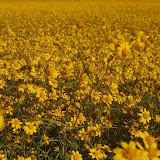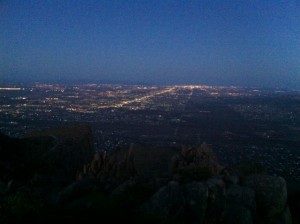 5:41 am. Sunday, October 3rd, 2010. Awaiting sunrise atop the Superstition Mounatins. Four million people, spread out in the valley below me. Yet not a soul for miles. Ed Abbey writes, Exultemus! Gloria in excelsis nihilo!
5:41 am. Sunday, October 3rd, 2010. Awaiting sunrise atop the Superstition Mounatins. Four million people, spread out in the valley below me. Yet not a soul for miles. Ed Abbey writes, Exultemus! Gloria in excelsis nihilo!
In the east, the first green light of dawn. Mountains. Few lights. The jutting poles of agave in their eternal migration up mountains like these.
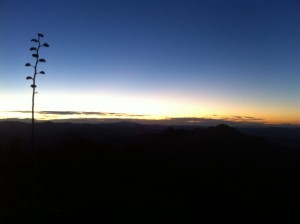 To the north, nothing also. Mountains. Haze. Particle dust. Streaming clouds, retreating away from sunrise.
To the north, nothing also. Mountains. Haze. Particle dust. Streaming clouds, retreating away from sunrise.
To the west, far off in the distance, South Mountain, it’s blinking red lights.
And in all the space between here and there, a million twinkling lights. Street lights, porch lights, illuminated parking lots.
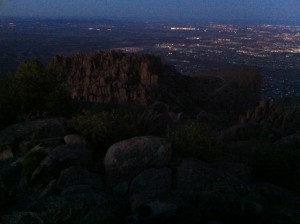 It shimmers and twinkles. It’s some expression of humanity. The pattern of the lights, it’s a human form. It’s organic, alive. A damn shame, but a delightful triumph.
It shimmers and twinkles. It’s some expression of humanity. The pattern of the lights, it’s a human form. It’s organic, alive. A damn shame, but a delightful triumph.
A coyote howls in the distance. Hiking up, I was accompanied by the hooting of an owl. The gaze of my headlamp happened to catch a rattlesnake who, despite shrinking from my light, did not deign to rattle.
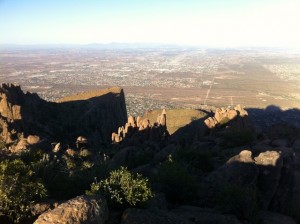 In the darkness, I walked through a spider’s web across the trail. I was startled to discover I’d picked up the spider on my leg. Hairy, the size of a quarter, and with palpable mass. I shrieked like a little girl but escaped unscathed.
In the darkness, I walked through a spider’s web across the trail. I was startled to discover I’d picked up the spider on my leg. Hairy, the size of a quarter, and with palpable mass. I shrieked like a little girl but escaped unscathed.
All for the delight of watching the sun rise, mountains appear, lights extinguished, the airport, and then city, come to life.




